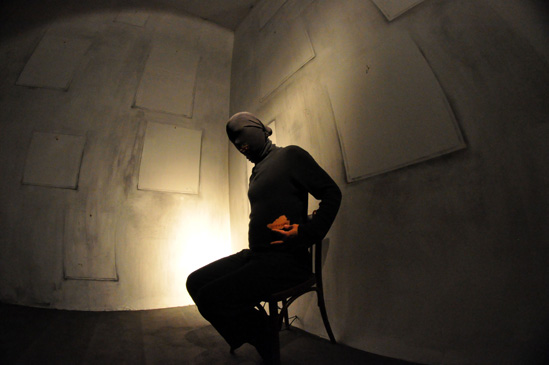Barbad Golshiri: Cura*; The Rise and Fall of Aplasticism, 2011. Video documentation of an aplastic play, performance at 4th Moscow Biennial. Image courtesy the artist, Thomas Erben Gallery and OtherIS; photo by Sergey Morozov.
Barbad Golshiri in his play, performance, and video documentation of the performance at the Moscow Biennial, 2011, locates a living (artist’s) body within a discursive space derived from a photograph of the Kasimir Malevich’s historic 0.10 exhibition. Both Malevich and Golshiri engage text, image, and experience in their respective reliving of the (exhibition) space that is circumscribed as “aplastic space.”
As the audience enters Kazimir Malevich’s room in 0.10: The Last Futurist Exhibition of Painting, it is dark. When lights go on, only nails and traces of the paintings that have been removed from their places in the famous photograph are visible. The performer sits on a chair; speechless, hooded, dressed all in black, with only his mouth and a wound to the left of his abdomen bared. The wound is a sentence in Braille cauterized on the flesh. He stretches his hand out to the viewers, takes their index fingers and leads them to touch the wound and read the script from left to right. When they touch the embossed dots, lights go off. Next day, the square patch of skin with the text is surgically removed without anesthesia. On the third day, the square of flesh is cured and placed inside a frame filled with salt. The frame is of the same size as Malevich’s Black Square; it is hung in its original place, the Red Corner.
